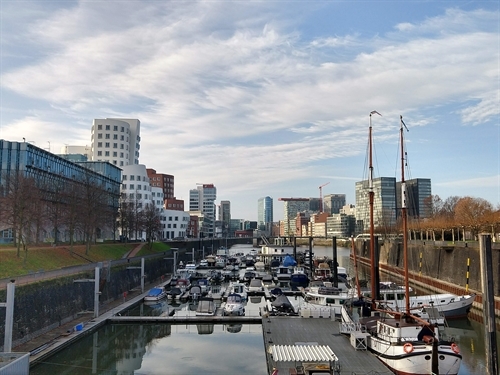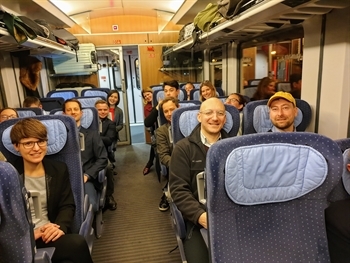MPC Associate Justin Keller recounts tales from the cutting edge of urban planning in Düsseldorf and beyond.

Image courtesy Toralf Herschel
Tweet this
Between December 8-14, 2019, I joined the Sustainable Urban Development Study Tour, hosted by the American Council on Germany (ACG). The tour included stops in Düsseldorf, Mannheim, and Heidelberg. Read the ACG’s summary here.
Some people studied Latin in high school because they wanted to go into pre-med. Others studied French with dreams of sipping un café along the Champs-Élysées. Then there were people, like me, who planned on becoming engineers and would benefit from some language ability on their near-monthly business trips to meet with BMW, Audi and Volkswagen. (That’s what engineers do, right?)
Life took me in a different direction. But who knew that a career in urban planning could take me to Germany, too, and that they would have so much to teach me?
Lessons and warning signs
The ACG provides programs and activities to strengthen relationships and deepen partnerships—once so strong in the postwar era but now waning—and to answer the question “Is Germany relevant to the United States?” with a definitive YES! The first full day of our tour began with a discussion with Fiona Evans, Consul General at the U.S. Consulate in Düsseldorf. Her primary focus is on commercial policy, helping U.S. firms set up shop in Germany and encouraging foreign direct investment in the United States. And, while I’m not in the business of international economic development, I'll gladly import the good ideas I've heard throughout the ACG’s Sustainable Urban Development Study Tour, most of which address common issues in urbanism and sustainability.
This is the first entry in a three-blog series, the point of which is not to say to American planners, "Why don't you do this?" nor, to German planners, "You should have done that." Rather, there are lessons from which, I hope, we all can learn.
No one expected Berlin to develop into a municipality bursting with 3.75 million residents and become a hotspot for artists, expats, …and skyrocketing rents.
On this tour, I heard good ideas and cautionary tales, both in equal measure. Regarding the latter, for example, no one expected Berlin to develop into a municipality bursting with 3.75 million residents and become a hotspot for artists, expats, …and skyrocketing rents. How could even the very best scenario planning have foreseen the fall of the Berlin Wall, the end of the Cold War, the rise of the EU, and the emergence of a reunified Germany as a major economic force in Europe and beyond?
Transforming urban spaces and causing unintended problems
Since its founding over 700 years ago, Düsseldorf has taken advantage of its location along the Rhine River to develop first as a fishing town and, later, as an industrial hub. Düsseldorf now finds itself at the center of the European transport network and right in the midst of a chain of expanding and overlapping urban areas, stretching west to Belgium and south to Switzerland and beyond.

Photo credit Justin Keller
Similar to the U.S., shifts in industry and manufacturing resulted in less need for its riverfront harbor, thereby opening it to be developed as a community amenity, if they could just do something with the honking glut of traffic separating their historic old town from the river.
As seen in Chicago, changing relationships with the waterfront resulted in great opportunities for placemaking efforts. In Düsseldorf, the traffic was moved underground and a beautiful, car-free public promenade was developed. Repurposed historic buildings were complemented with modern architecture, including a trio of buildings by Frank Gehry, and the entire area was transformed (with some missteps) into a modern, live-work-play district for the Digital Age, right in the city center. As you might imagine, though, this is not the cheapest real estate in the city, and clear parallels can be drawn to some of the problems in Chicago’s West Loop neighborhood and elsewhere in the city, prompting the question: can we have investment while maintaining affordability?
Though there is now a beautiful amenity, planners are contending with 12% population growth over 10 years despite projections that the population would remain stable, and the city is struggling with a housing shortage and high rents. Regulations require a combined 40% of publicly subsidized and affordable housing but only when a development is party to a land-use plan, usually when the development will include hundreds of units. The affordable housing problem is a result of many German cities having privatized their housing departments and belatedly trying to re-intervene (you can read a bit about this here); I will discuss this in more depth in a subsequent post. This is something we struggle with in Chicago, too, and something the Affordable Requirements Ordinance is trying to remedy.
Unable to find affordable housing within the city, approximately 300,000 people commute into the city daily (the city’s population is just under 650,000). Simultaneously, among big German cities, Düsseldorf has the highest car density, highest proportion of households with two cars, and lowest proportion of car-free households. The effect this is having on air quality is substantial. Going forward, planners are transitioning from “transportation planning” to “mobility planning”, with higher parking fees and greater implementation of HOV/taxi/bicycle lanes to complement their already-robust public transit network.
Thankfully, planners do not have to tackle this problem on their own. The local energy utility is also helping to offset both costs and emissions.
Participation by all sectors can help achieve sustainability goals
Faced with a rapidly growing population and the CO2 emissions from a large commuter population, Stadwerke Düsseldorf—the municipal energy utility—chose to upgrade its Lausward Power Plant in a way that would reflect growth patterns while not contributing to the existing pollution problem. In addition to setting three world records, the design by Siemens is highly energy-efficient, and the system collects energy wherever it can.

Photo credit Justin Keller
The older parts of the plant which used to burn coal have been converted to burn natural gas, and a new “combined heat and power” plant uses exhaust from the gas facility to turn a steam turbine and generate additional energy. The excess heat is then distributed to the district heating system which, in the face of rising costs of rent, helps lower costs of living while also being highly sustainable. The heat provided has an energy factor of zero, meaning it has the same impact as 100% renewable energy.
Stadwerke Düsseldorf has a goal of climate neutrality by 2050. To achieve this, the utility operates other sustainability initiatives, such as natural gas stations for cars that run on this fuel source, an e-scooter sharing program, and “mobility stations” outside of train stations for charging electric cars and scooters which, to my mind, is taking “Park and Ride” to the best level.
Gone are the days of urban planners thinking they can single-handedly design the ideal, utopian city.
In a subsequent meeting with the Secretary of State, Dr. Jan Heinisch, from the amazingly-named Ministry of Regional Identity, Communities and Local Government, Building and Gender Equality of the Land of North Rhine-Westphalia, we learned that the power plant’s sustainability initiatives are in line with UN’s Sustainable Development Goals but also come out of public opinion. These are not simply tick-a-“sustainability”-box initiatives for grant applications. Rather, they are informed by annual town hall meetings to shape planning priorities. Germany has long been at the forefront of the “green” revolution (so says my Lonely Planet guidebook), but, indeed, it shows what can be accomplished when the populace speaks with one voice on sustainability goals. The technology clearly exists.
Teamwork makes the dream work
At the end of our first full day in Düsseldorf, we met with Lutz Knappmann, Editor of the weekly business news publication, WirtschaftsWoche. This was the first meeting with someone who wasn’t a government employee—as a counterpoint to the Lord Mayor, Consul General, State Secretary, City Planner, and others—and also the first time we realized that the members of our tour group were, in fact, experts in urban sustainability. We coalesced as a group that evening as we had an open and honest conversation about the woes facing many German and American cities.

Photo courtesy Robin Cammarota
Since many of the German attendees live and work in Berlin, that city was a major focus of the conversation, in particular, the need for interdisciplinary cooperation:
- Cities are building schools like crazy, but there are not enough teachers in the pipeline to fill the vacant positions. How can we incentivize students to become teachers? Are we already too late to fill the gap?
- Child care is subsidized by the government, and every child is guaranteed a spot, but there aren’t enough spots to go around. The “lucky” people will find an opening for their child, but it is common for them to have to travel as much as one hour! How can we make sure good-intentioned government programs are implemented in a way that results in the desired outcome?
- Housing costs are obscene, and rural areas attract people away. Some companies even subsidize their travel, but this leads to congestion on the roadways and increased air pollution. What interventions can stem the rising costs of housing? What role can improved transit play?

Photo courtesy Toralf Herschel
These are big questions that no single discipline or sector can answer on its own. Gone are the days of urban planners thinking they can single-handedly design the ideal, utopian city. These challenges require collaboration across governmental departments, and we need to bring in professionals beyond the engineers, architects, developers and those who are traditionally aligned with planners. Every aspect must be addressed, and we need the right mix of scaffolding to support these programs and make sure they succeed.
And all the better if there is a department tasked with strategic oversight to help these actors work better together towards a common goal… As will be discussed in my next post about the City of Mannheim and their Strategic Controlling Office. Stay tuned!